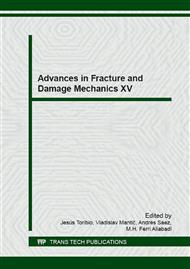p.297
p.301
p.305
p.309
p.313
p.317
p.321
p.325
p.329
Fretting Wear Simulation in Fiber-Reinforced Composite Materials
Abstract:
This work presents a numerical formulation to compute wear in ber-reinforced composite materials that are subjected to fretting wear contact conditions. The formulation is based on authors' previous works [1, 2] and presents contact and wear constitutive laws which consider micromechanical aspects such as the ber orientation relative to the sliding direction, the ber volume fraction or the ber length. The formulation uses the Boundary Element Method (BEM) for computing the elastic in uence coef cients and contact operators over the augmented Lagrangian to enforce contact constraints. The proposed formulation is applied to compute and study wear in different carbon berreinforced bulk and fi lm con gurations.
Info:
Periodical:
Pages:
313-316
Citation:
Online since:
September 2016
Authors:
Price:
Сopyright:
© 2016 Trans Tech Publications Ltd. All Rights Reserved
Share:
Citation:


